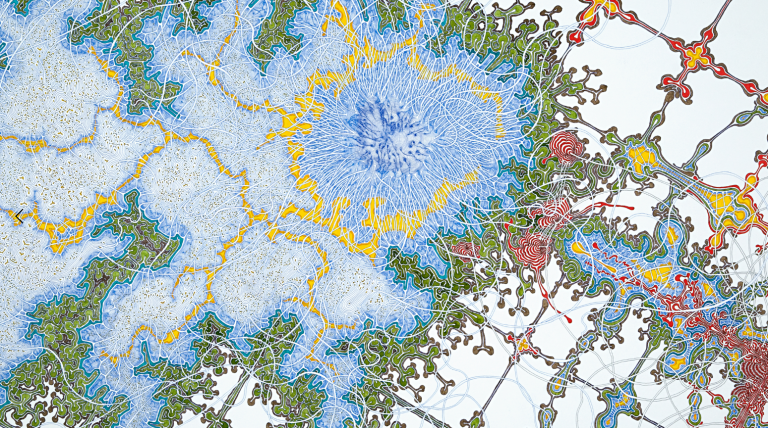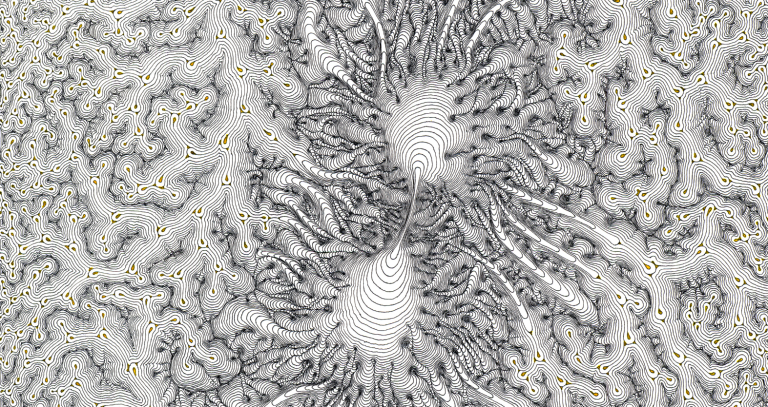 Symbiomatrix, 2011 (Ink and acrylic on paper)
Symbiomatrix, 2011 (Ink and acrylic on paper)
“Daniel zeller was born in San Rafael, California in 1965. He completed his MFA in Sculpture at the University of Massachusetts in 1988 and his BFA Sculpture in 1993 at the University of Connecticut. Since the late 90’s he has been living and working out of Brooklyn, NY.” (Zeller, 2014). Daniel Zeller’s paintings and drawings tend to use traditional mediums such as graphite, ink, and acrylic paint. However the manner in which he implements them creates a new area under their computational ceiling to produce art that is unique to him. A single glance is enough to notice the labor intensive repetition that Zeller uses in his work. A closer look is enough to cause astoundment at the articulate and precise lines pulsating throughout the picture. And single a step back is enough to let one absorb the work as a whole and be taken back by the collective network of lines interacting with one another to form an image close to but still easily distinguished from reality. Most of Zeller’s art consists of short lines with long flowing rhythmic lines cutting between them.”His technique requires a meticulous and obsessive repetition as well as a series of spontaneous decisions governed by self-imposed rules and conditions”(Michel Soskine Inc, 2011). This method is especially well suited to mimicking images that we perceive in two dimensions.
Take for example Vatican / Masjid al-Haram by Zeller. At first glance it bears a striking resemblance to a satellite image of an old city next to a series of crop fields interspaced by thin dirt roads. But look closer and the roads wind and twist over each other in a manner no road could.This kind of peculiarity is found in many of Zeller’s works. He will often draws in a way that resembles reality then insert subtle detail to make his work to bizarre to concretely mirror what is real. Whenever he does this he normally draws something akin to a map or a microscopic organism.
 Vatican / Masjid al-Haram, 2012 (Graphite on paper on panel)
Vatican / Masjid al-Haram, 2012 (Graphite on paper on panel)
Perhaps my favorite example of this is in his work “Quality Control”which is meant to bear resemblance to a topographical map. In topographical maps the curved lines that contour around each other form terrain features by indicating elevation. These lines paint a picture of what the land looks like to whomever has been trained to read them. Zeller does exactly this in this work but in such a way that what he draws couldn’t exist in reality. This drawing, if interpreted as a map, would depict many incredibly steep rolling hills tightly woven together dominated by of two mountains who share a single peak that forms an arched bridge between them. If this work were reinterpreted as a landscape drawing it would be of surreal terrain that could only be encountered in some sort of science fiction novel or fever dream.

Quality Control, 2015 (Ink on paper)
Zeller’s work is undeniably unique and with their peculiarity comes their value.“Zeller’s works collected globally by private and important art institutions most notably The Museum of Modern Art, The Whitney Museum, The Los Angeles County Museum of Art, The Museum of Contemporary Art, Los Angeles, The Albright-Knox Art Gallery and The National Gallery of Art in Washington, DC, amongst others.” (Gleichapel, 2014) He is by no means famous but his work has caught the eye of many people trained to recognize talent.
Sources
Gleichapel. “Daniel Zeller.” Gleichapel – Daniel Zeller. Accessed October 01, 2017. http://gleichapel.org/artist-details.php?artist=Daniel Zeller.
Michel Soskine Inc. “Daniel Zeller.” MICHEL SOSKINE INC. June 11, 2011. Accessed September 28, 2017. http://www.soskine.com/artists/daniel-zeller.
Zeller, Daniel . “Bio.” Daniel Zeller. Accessed September 28, 2017. http://www.danielzeller.net/bio/.
Zeller, Daniel . “Vatican / Masjid al-Haram: Graphite on paper on panel, 40 x 50″, 2012.” Daniel Zeller. Accessed September 28, 2017. http://www.danielzeller.net/artworks/.
Zeller, Daniel . “Quality Control: Ink on paper, 13.5 x 11”, 2015” Daniel Zeller. Accessed September 28, 2017. http://www.danielzeller.net/artworks/.
Zeller, Daniel . “Symbiomatrix: Ink and acrylic on paper, 30 x 37 inches, 2011” Daniel Zeller. Accessed September 28, 2017. http://www.danielzeller.net/artworks/.
I love Zeller’s use of line in these pieces. I was curious to see more of his work and was able to find plenty of examples online. I particularly like his pieces that incorporate color. He seems to use mostly primary colors: red, blue, and yellow, with occasional greens, purples and oranges. The lines he often uses are more organic than geometric, resulting in pieces that feel natural in a rather mystical sense. Overall, I thoroughly enjoy Daniel Zeller’s work.
-Amanda Sulz
LikeLike
Zeller’s drawings that look realistic but are impossible in real life remind me of the magical realism genre in literature, where fantastic elements are told in such a way that they sound real even if they cannot possibly be. The work Quality Control looks like a recursive graphic, which is the use of the output of a function as its input, and repeating the process a certain number of times. Recursive graphics are used in mathematical art, which, like Zeller’s work, display meticulously rendered patterns. Zeller’s work is very hypnotic, and it is hard to not become drawn into the pieces. Despite drawing hectic patterns, the drawings still appear very orderly, which speaks to Zeller’s attention to detail.
LikeLike
-Nina Marciano
LikeLike
It is really cool how many different ways Zeller’s art can be interpreted. With a name like “Quality Control” and a drawing that is just a collection of long curved lines we really don’t have much to go on. But seeing how his work takes on meaning to each of us individually is cool to witness. Prior to reading your post I didn’t even know what a recursive graphic was but now that I do I can say what I thought of as a surrealist map also strongly resembles a type of mathematical artwork. I think that a lot the value in Zeller’s artwork comes from the way it is open to interpretation.
-Isaac Goliday
LikeLike
Zeller’s drawings reference the reality he sees and twist them into the impossible. Upon first glance, I believed that he was just recreating a Google Earth style of map. However, while looking deeper into his “Vatican”, the lines curve and take on a life of their own. His images are familiar and, because of this it makes the viewers search for the differences among what they have seen before and his work. I really love the work with color, however his “Quality Control” is almost an optical illusion of sorts. Zeller’s drawings are extremely precise and intricate, especially considering the media his works are made in.
-Amy Kruse
LikeLike
Zeller’s work shows close relation to topographical maps that are used in construction. The deliberate quality of the lines used in his works give the impression that he’s spent a meticulously long time producing each piece. To me, this is a very admirable skill as I struggle with spending tedious amounts of time of any type of project even if they need it to be of high quality. Another technique that Daniel Zeller has appeared to master, and one that I envy, is value shading. The subtle changes in depth in “Vatican / Masjid al-Haram” are extremely believable and influence the overall effectiveness of the piece.
LikeLike